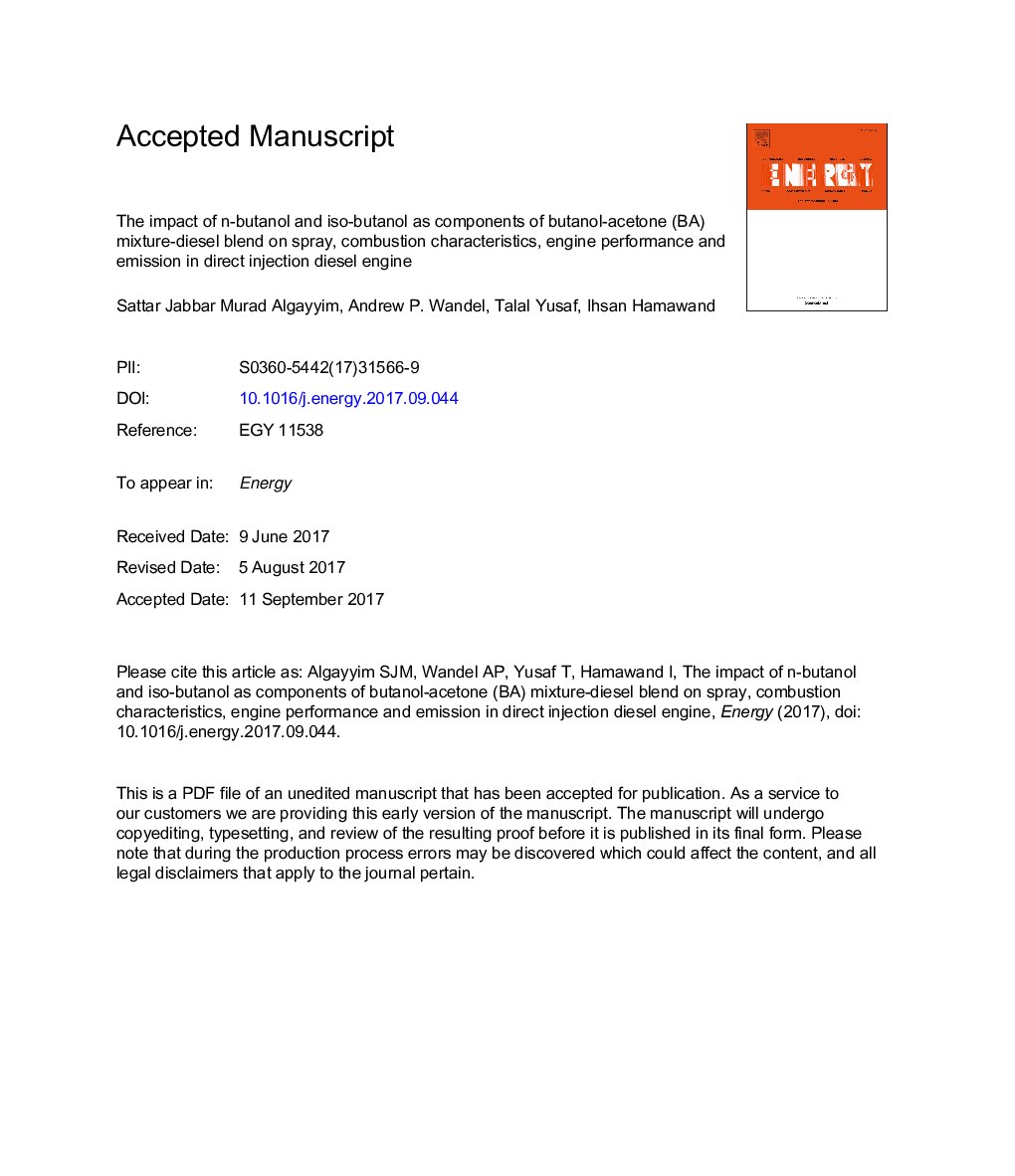| کد مقاله | کد نشریه | سال انتشار | مقاله انگلیسی | نسخه تمام متن |
|---|---|---|---|---|
| 8072696 | 1521411 | 2017 | 44 صفحه PDF | دانلود رایگان |
عنوان انگلیسی مقاله ISI
The impact of n-butanol and iso-butanol as components of butanol-acetone (BA) mixture-diesel blend on spray, combustion characteristics, engine performance and emission in direct injection diesel engine
دانلود مقاله + سفارش ترجمه
دانلود مقاله ISI انگلیسی
رایگان برای ایرانیان
کلمات کلیدی
موضوعات مرتبط
مهندسی و علوم پایه
مهندسی انرژی
انرژی (عمومی)
پیش نمایش صفحه اول مقاله

چکیده انگلیسی
This article assesses the impact of n-butanol (nB) and iso-butanol (isoB) as components of a butanol-acetone (BA) mixture on spray, combustion, engine performance and emission characteristics. The macroscopic spray characteristics including spray penetration, spray cone angle and spray volume of n-/iso-BA-diesel blends were measured at two injection pressures 300 bar and 500 bar. A direct visualisation technique high speed camera was used to analyse the images that were obtained. The spray results show that both n- and iso-BA-diesel blends achieved a slightly higher penetration distance compared to pure diesel, resulting in a better fuel-air distribution and mixing. Two blend ratios (10% and 20%) of iso- and n-BA-diesel blends were tested in a single-cylinder DI diesel engine at three engine speeds: 1400, 2000 and 2600 rpm at full load. The engine performance included measuring the following parameters: pressure inside the combustion cylinder; brake power (BP); and brake specific fuel consumption (BSFC). The exhaust gas emissions included measuring the following parameters: exhaust gas temperature (EGT); oxide of nitrogen (NOx); unburnt hydrocarbons (UHC); carbon monoxide (CO); and carbon dioxide (CO2). The results from the blended diesel with iso- and n- BA were also compared to pure diesel as a baseline. The results for 10 iso-BA-90 diesel showed a slight improvement in BP by 4% at medium speed, while the BP of 20iso-BA-diesel, 10 and 20 n-BA-diesel was slightly lower and comparable with pure diesel at all engine speeds. The highest peak in-cylinder pressure was measured for the iso-BA-diesel blends. BSFC and BTE were increased for both iso- and n-BA-diesel blends. CO emission reduced with the increase in both n-BA and iso-BA ratios in diesel blend. Both NOx emissions and EGT were decreased at all n-BA and iso-BA-diesel blends compared to pure diesel. UHC and NOx emissions concentration of n-BA-diesel blends were lower compared to that of the iso-BA-diesel blend. Thus, it can be concluded that iso-BA-diesel blends showed slight improvement in brake power and higher in-cylinder pressure, while n-BA-diesel blends resulted in lower emission levels in regard to NOx and UHC. Therefore, using n-BA and iso-BA blended together as an additive for diesel fuel could be a suitable blend to obtain optimum results in regard to engine performance.
ناشر
Database: Elsevier - ScienceDirect (ساینس دایرکت)
Journal: Energy - Volume 140, Part 1, 1 December 2017, Pages 1074-1086
Journal: Energy - Volume 140, Part 1, 1 December 2017, Pages 1074-1086
نویسندگان
Sattar Jabbar Murad Algayyim, Andrew P. Wandel, Talal Yusaf, Ihsan Hamawand,